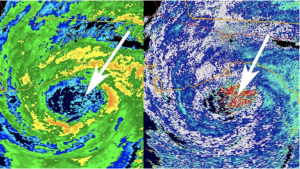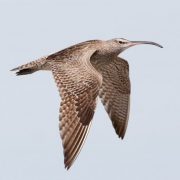In the Eye of the Storm: How Birds Survive Hurricanes
By Juliana Smith
Hurricane season strikes the Eastern seaboard of the United States every summer and, guess what? We’re in it right now! The season begins in June and runs through November, but as we here on the East Coast know, storms can arrive as early as April. While hurricanes often conjure images of wind-torn towns and flooded highways, their impacts on wildlife are less impressed upon human minds. However, wildlife also experience the forces we humans contend with, and birds are no strangers to hurricane season.
Being a lightweight, feathered animal has its perks (ahem, the ability to fly), but can also be incredibly debilitating when faced with extreme winds. Unfortunately, hurricane season coincides with Fall migration, so many birds are forced to face these powerful storms head-on. Yet, despite the odds, bird populations largely succeed at weathering the season. Of course, not every avian individual or community survives hurricanes, but in general, it appears birds have developed four tactics to help ease them through the stormy spells.
When a storm is on the rise and headed our way, we have weather forecasters and doppler radars to warn us of impending natural disaster. Birds, while not equipped with our high-tech gadgets, can sense that trouble is nigh when they pick up on the drops in air pressure that precede storms. Some birds take their cue and surf the headwinds of the hurricane, using them to get them out of dodge as quickly as possible. If conditions are right, migrating birds can even use the storm’s headwinds to get a wing up on their migratory journey.
Other birds, though, might use the eye of the storm as a refuge during a hurricane. This tactic seems to be especially popular with seafaring birds, though there’s no way to confirm their intent. Birds caught up in the storm might chance upon or follow winds to the eye where things are calm. Once there, they are effectively trapped, or “entrenched”, at the center of the hurricane and will follow it until the outer spiraling winds weaken, much to the delight of birders. Entrenched birds often wind up hundreds of miles from their home habitat, creating a fallout of rare sightings in inland habitats. Groups like Team Birdcast hope to utilize these events paired with eBird reports to better understand the relationship between hurricanes and birds.

Hurricane Hermine (2016) doppler radar imaging. The red blotching in the right image is a flock.
It’s important to understand that displaced birds shouldn’t be disturbed. While it is definitely better to be within the eye of the hurricane than be in the spiral, eye riding, as it’s sometimes called, isn’t exactly relaxing. It not only forces birds hundreds of miles from their home habitat, but can deprive them of food and rest for many days at a time. Those that survive until the storm dissipates then have to make a long return journey home. Even with the risks, though, it certainly seems safer to seek refuge in the eye than fight the storm.
And yet, some birds have done just that, flying directly through storms. We’ve only recently stumbled upon this behavior thanks to satellite transmitters and some spunky whimbrel . In 2011, researchers were astonished to find that one of their tracked subjects, a tagged whimbrel, had actually forced her way through Hurricane Irene. Since then, other members of the same species have been recorded using a similar tactic to survive hurricanes. Interestingly, researchers believe that migration is one of the factors allowing these whimbrels, and unknown others, to push through. Before migrating, birds will beef-up and pack on as many fat stores as possible to help supply them much-needed energy through their long migration routes. Researches believe it’s these fat stores that give some birds the power to fly straight through nature’s most wicked storms.
While some birds are skirting, riding, or cutting through hurricanes, others are hunkering down at home. Equipped with a clamping back toe, passerines are capable of weathering hurricanes by clinging to tree branches or seeking refuge in tree cavities. This author has even witnessed a small flock of house finches huddled under stowed kayaks to hide from Tropical Storm Irma in 2017. Tree clamping through a hurricane has its obvious risks, especially if your chosen branch is knocked from the tree (or your kayaks get flooded), but it also preserves fat stores and reduces risk of getting blown hundreds of miles from home.
In the end, different birds take different measures to survive hurricanes, but all of the methods showcase avian tenacity and perseverance. They truly are remarkable animals capable of seemingly impossible feats.



